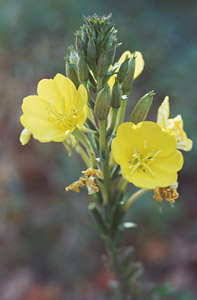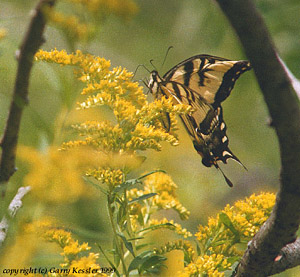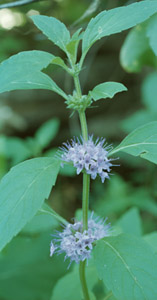
Common Evening-Primrose, Evening-Primrose Family (Onagraceae), Native


|

This hardy plant is biennial, living for two years. The first year it grows as a rosette or low cluster of leaves, and the second year it sends up a tall flower stalk and blooms. Its deep tap root can be boiled and eaten the first year, and its young leaves can be used in salads or cooked as greens. In the early 1600s, colonists sent this native plant back to Europe, where it was then cultivated as food.
Common evening primrose had medicinal uses among Native Americans, who made a root tea from it and also used
the root in poultices and as a rub. The seed oil is a good source of gamma-linolenic acid, which the human body
needs. Modern research has found that the seed oil may be helpful in treating eczema and a range of other
ailments. It is licensed in England for treating skin inflammation, premenstrual syndrome (PMS), and
breast pain.
Goldenrod, Composite or Daisy family (Compositae), Native
  |
| |

Goldenrod is often wrongly blamed for causing hay fever, probably because it blooms during the height of hay fever season. In fact, most hay fever is caused by ragweeds, such as common ragweed (Ambrosia artemisiifolia) and great ragweed ( Ambrosia trifida,). Unlike goldenrod, these ragweeds are wind-pollinated. They produce vast quantities of tiny, light pollen that readily becomes airborne. Goldenrod pollen is heavier and better suited for transport by bees.
People who pick goldenrod for late-summer bouquets may sometimes be surprised to discover that they have also brought home insects. A single goldenrod plant can contain a diverse insect community. Goldenrod flowers offer a rich supply of nectar, especially as other sources begin to dwindle with the approach of fall. The flowers attract bumblebees and honey bees, as well as flies that resemble them, complete with yellow and black stripes. Butterflies, ants, and wasps also frequent goldenrod.
Predatory insects often hunt in goldenrod. They include yellow jackets and the yellow goldenrod spider
( Misumena vatia), which is one of the 200 crab spiders (Thomisidae family) that are colored like
the flowers they hide in. Instead of spinning a web to trap prey, crab spiders lie in wait, camouflaged,
and grab and paralyse other insects. Another typical predator is the yellow ambush bug
(Phymata crosa), which also hides and seizes insect prey. Goldenrod plants may also harbor a
type of "praying mantis", which also consumes insects.
Wild Mint, Mint family (Labiatae), Native
 |
 |
 |
Wild mint (Mentha arvensis) grows on wet shores of the Reservoir. The plants have the characteristic square stem of mints, a scent of mint, and clusters of small fuzzy-looking flowers growing where leaves and stems meet. The flowers can be light purple or white, and both are found at the Reservoir. The plants spread by underground runners and can form colonies.
Wild mint is native to North America, unlike spearmint (Mentha spicata) and peppermint
(Mentha piperita), which come from Europe and bear flowers on spikes. Native Americans used
wild mint as a tea and as a flavoring for meats, much as we do today with various mints, especially
spearmint. Some Native American groups used wild mint to treat nausea.
| hide TOC | 
|
| Home / Contact | ||
Copyright © Anne A. Reid, 1999-2002. Photographs copyright © Garry K. Kessler, 1999-2002. | ||